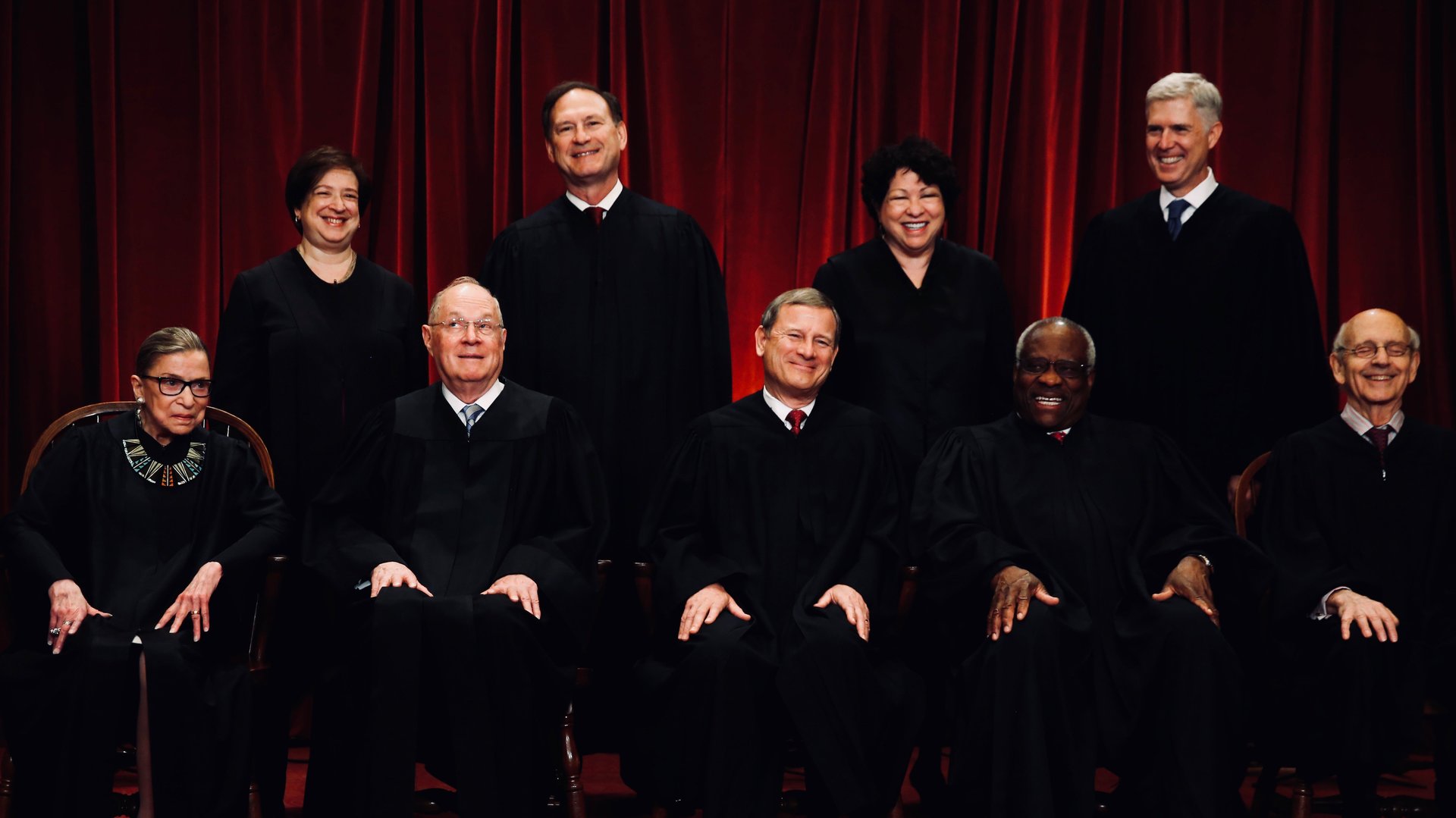Sonia Sotomayor is writing a book for tweens, and more Supreme Court revelations
The most powerful judges in the US don’t just sit on the bench. The Supreme Court justices do side gigs, too.


The most powerful judges in the US don’t just sit on the bench. The Supreme Court justices do side gigs, too.
Their 2017 financial disclosures, released on June 14, reveal what the judges get up to when they’re off-duty and how they supplement their salaries. Supreme Court associate justices earn $251,000 a year, and the chief justice, John Roberts, made $263,000 in 2017. But they also earn income from speaking engagements, writing, teaching, investments, and more, all of which they must each disclose annually.
Here are the highlights from the judges’ financial reports:
Sonia Sotomayor, tween writer
The associate justice reported (pdf) $117,500 in advances from the publisher Penguin Random House for two books. Although the disclosure statement doesn’t reveal what Sotomayor is working on, Fix the Court says Sotomayor is writing a tween adaption of her memoir My Beloved World as well as a chronicle of the books that most influenced her life. Of the justices, she is the highest-earning writer. Sotomayor is also the only justice to report any debt—she has an outstanding mortgage for a rental property in New York, owing between $250,000 and $500,000. The property is worth between $1 to $5 million dollars.
Ruth Bader Ginsburg, avid traveler
The notorious RBG earned $25,000 (pdf) last year as a visiting fellow at Stanford University. She also taught abroad in Malta, which yielded $2,765. The justice doesn’t reports any earnings from the RBG Workout video created with her trainer last year. Ginsburg took the most reimbursed trips of all nine justices.
Stephen Breyer, architecture judge
The winner of the prize for most unusual side gig goes to Breyer for his position as a juror on the Pritzker Architecture Prize committee. The work took him to Lima, Peru and to Mexico City, Mexico, but it wasn’t a paid position. Breyer’s writing yielded $4,765 in royalties (pdf) from Penguin Random House. He sold sold up to $100,000 in Cisco stock, up to $50,000 in Air Products & Chemical holdings and up to $15,000 in Versum Materials.
Elena Kagan, true to her alma mater
Kagan also taught last year, earning $17,500 (pdf) as a visiting professor at her law school alma mater Harvard University. She returned to Harvard to give speeches in September and October but wasn’t paid for these events, just reimbursed for meals, transportation, and lodging. The details about reimbursements aren’t disclosed, so we don’t know where she stayed or ate.
John Roberts, Irish cottage owner
The chief justice was the only member of the high court to receive a gift in 2017 (pdf). Federal judges in Mississippi gave him an inscribed football helmet worth $579. Roberts earned $10,000 for a teaching gig at the University of Melbourne Australia and $10,000 for work at the Victoria University of Wellington in New Zealand. He disclosed that he is part-owner of a cottage in Limerick, Ireland. Last year, Roberts also sold securities worth up to $50,000 in Hill-Rom Holdings, up to $15,000 in Hillenbrand, and up to $15,000 in Nokia.
Anthony Kennedy, a financial minimalist
Kennedy taught closer to home (pdf) than Roberts, earning $12,500 for a stint at McGeorge Law School in Sacramento, California. He had a slew of reimbursed speaking engagements, which he appears to have attended with his wife on occasion. He also reports that she earns money from the California teachers retirement fund. Kennedy has the simplest financial portfolio of anyone on the court—no securities or trusts, just cash in a bank account and three life insurance policies.
Clarence Thomas’s working family
Thomas holds a volunteer position on the board of directors at the Horatio Alger Association, a nonprofit that offers need-based college scholarships, and earned money from three teaching gigs. He made $12,000 (pdf) from the George Mason Scalia School of Law in Virginia; $10,000 teaching at Creighton Law School in Omaha, Nebraska; and $5,765 from George Washington University School of Law in Washington, DC. According to his report, Thomas’s wife also had a couple of jobs, earning income from the conservative website The Daily Caller and Liberty Consulting, Inc.
Samuel Alito, shopping for securities
Alito earned $15,000 teaching at Duke University Law School in Durham, North Carolina and $12,765 from Loyola Law School at the University of Chicago. He was the only justice to purchase securities in 2017. While Alito sold up to $100,000 in medical technologies company CR Bard and up to $15,000 in Schlumberger, an oilfield services provider, he acquired up to $15,000 in medical device-maker Becton Dickinson.
Neil Gorsuch’s real estate deal
The court’s most junior member earned $9,020 in royalties from a book about the future of assisted suicide and euthanasia. He was also paid $2,060 to teach at the University of Colorado Law School before he took the bench last year. He sold his 2,923 square ft. central Colorado property and the 40 acres of mountain it sits on for up to $500,000.
Taking stock
The justices’ financial disclosures are closely watched because of the potential conflicts of interests that may arise from their stock holdings. According to Fix the Court, a “non-partisan grassroots organization created to take the Supreme Court to task,” about 50 times a year, justices are often discovered to own shares in a petitioner’s company and must recuse themselves from the case.
In a statement on the 2017 financial disclosures, FTC executive director Gabe Roth writes, “Luckily, only three justices own individual stocks, and they’ve slowly begun selling them off. But if savings accounts and retirement funds are good enough for two-thirds of the justices, then these types of investments, which almost never yield recusals, should be fine for all nine.”